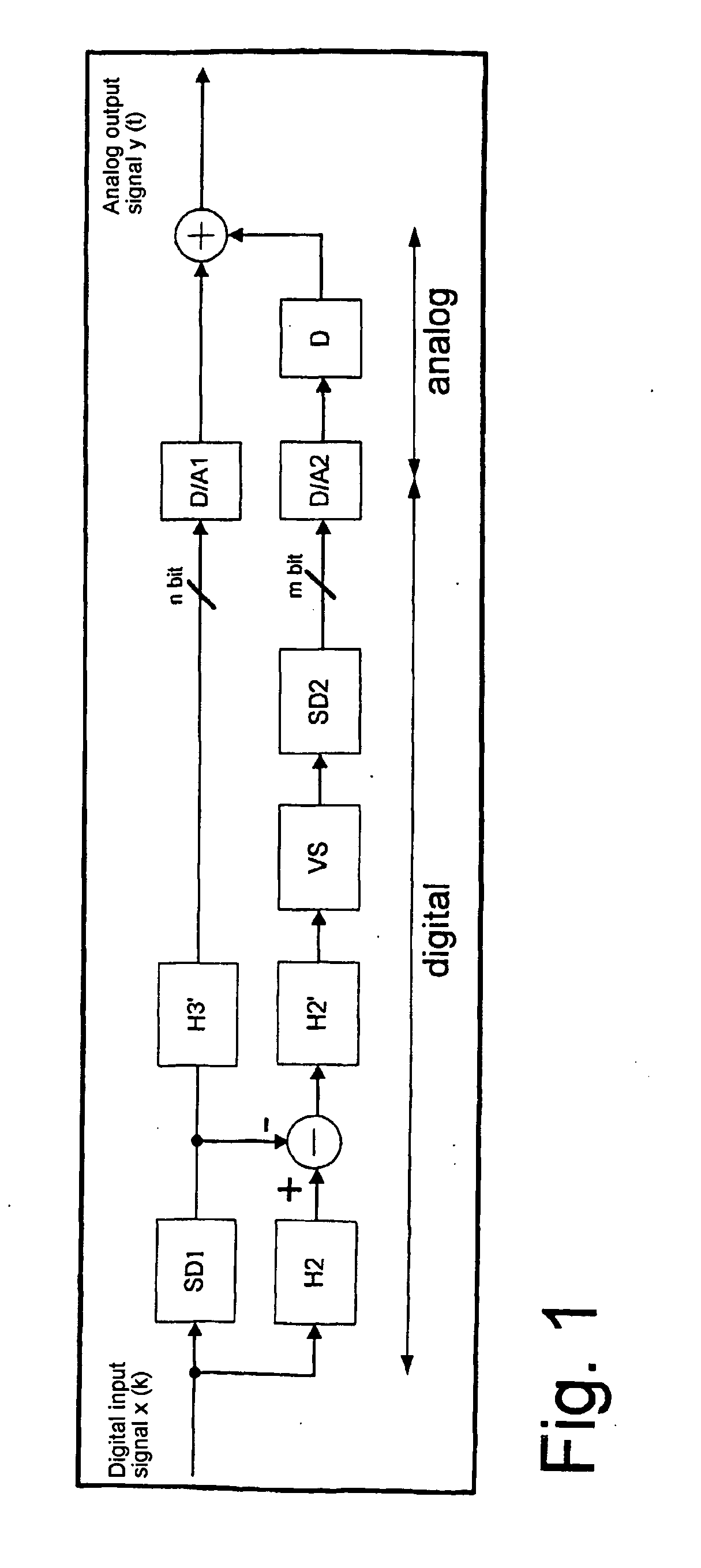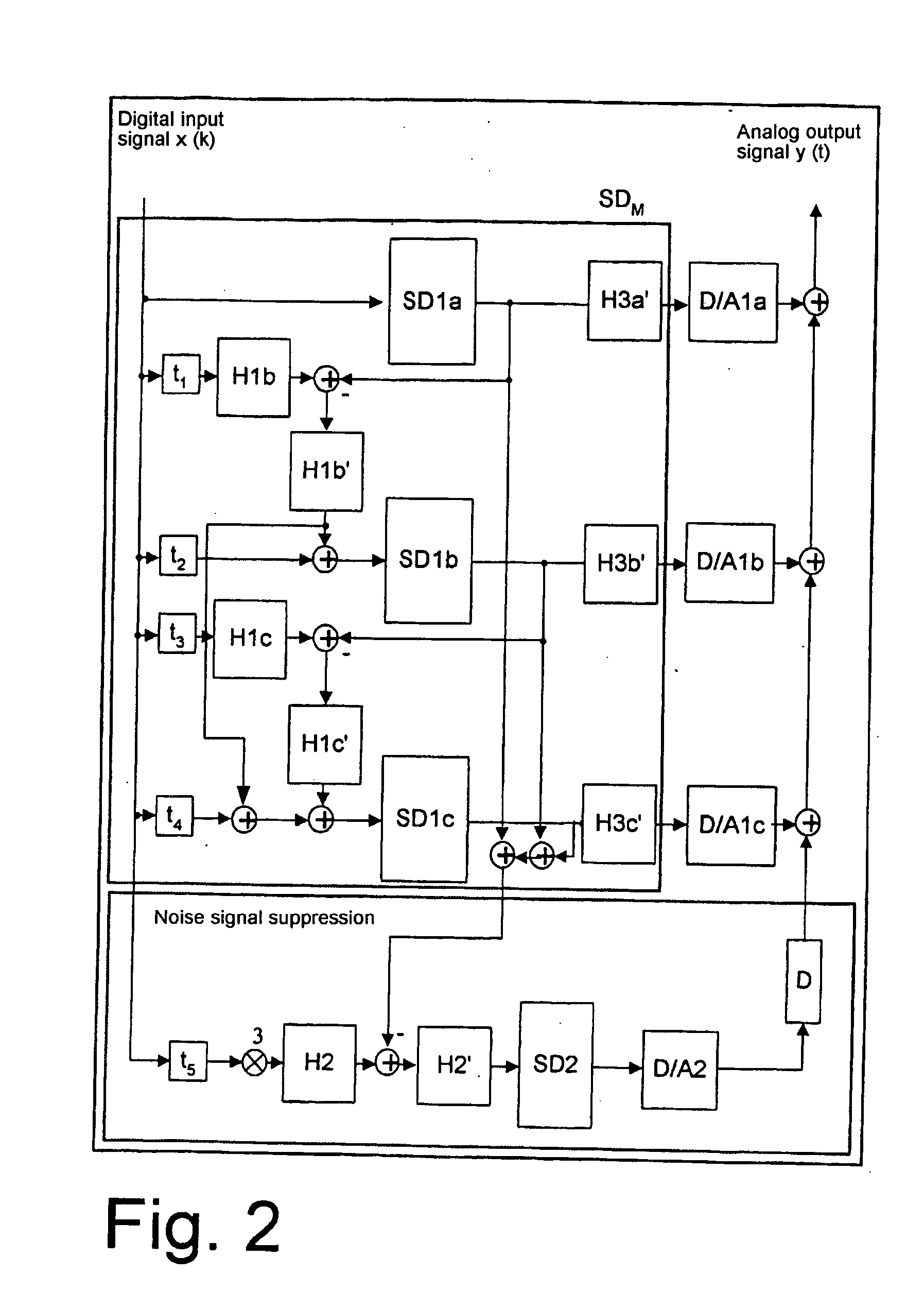The
spectral shaping of the input signal x(k) in accordance with the
transmission function of the sigma-delta modulator in the principal path and the subsequent differential formation with the digital output signal of the sigma-delta modulator essentially isolates the quantization errors of the sigma-delta modulator in the principal path. The subsequent filtering then attenuates the
noise components outside the useful band which represent the fundamental components of the
noise power. This structure of a sigma-delta converter overlays the signal components of the principal and parallel paths constructively, while the noise components of the two paths are overlaid destructively. As a result, the quantization noise of the sigma-delta
converters can be compensated for at least partly. This parallel circuit functions without feedback paths.
If the fundamental components of the
noise power are suppressed, the amplitude of the signal can be increased without the sigma-delta modulator being overdriven.
In a development of the invention, the principal path is configured in such a way that compensation filtering is provided after the
branch to the parallel path and before the digital to analog conversion. The compensation filtering in the principal path can compensate for the propagation times and the frequency responses in the parallel path which contains a filter, an
amplifier and a sigma-delta converter. This additional filter can compensate for error components in the parallel path.
The sigma-delta converter in the principal path is advantageously configured as a multi-stage sigma-delta converter. In multi-stage sigma-delta
converters, the principle of the onward transfer of the quantization noise can be exploited with the result that the quantization noise of the individual stages is overlaid destructively, that is to say the
noise component of the overall sigma-delta converter does not increase directly proportionally to the number of stages of the multi-stage sigma-delta converter, but less than proportionally. Moreover, the use of multi-stage sigma-delta converters makes it possible to combine different properties in different stages.
The sigma-delta converters are advantageously configured as 1-bit sigma-delta converters where the 1-bit sigma-delta converter and therefore the 1-bit
digital to analog converter can possess unequal output powers. With respect to the
noise shaping of the multibit sigma-delta output signal generated, this embodiment initially appears to be a
disadvantage since the sigma-delta modulators are reliant on the stability limits and control range of a 1-bit sigma-delta modulator. Taking account of unequal output powers (mismatch) of the individual 1-bit digital to analog converters, however, this evaluation is turned around into an
advantage: alongside the noise of the multibit sigma-delta output signal generated, the in-band noise now also contains noise components which spectrally shape the 1-bit data streams and are also included in the in-band noise in accordance with the output signal power differences of the individual digital to analog converters. No post-positioned
algorithm, which generates a plurality of 1-bit data streams from the multibit signal and which, due to the restriction of reproducing a multibit signal, only achieves sub-optimum
noise shaping for each of these
individual data streams, is now needed with the proposed structure. Each individual 1-bit
data signal is spectrally formed in an optimum manner and guarantees low in-band noise in the case of high mismatching. The principle of noise signal suppression described above now makes it possible to improve the fundamental
disadvantage of the sigma-delta modulator—the reduced in-band noise signal shaping—considerably over and above the amount achievable by the multibit sigma-delta analog to analog converter used up to now.
With a view to an inexpensive and technically flexible method of manufacture, the sigma-delta converter can be manufactured in
CMOS technology (Complementary
Metal Oxide Silicon).
 Login to View More
Login to View More  Login to View More
Login to View More 


